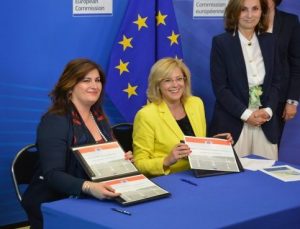Although one can always do better, our Ministry is of the opinion that, last year, we reached the optimal pace of competition launches and contracting Europe-funded projects. If it continues at this pace, Croatia will be able withdraw all 10.7 billion euros of EU funds at its disposal by 2020, despite the late start.
Up until recently, the people in Croatia had a good enough reason to claim that they could not see the benefits of their country joining the EU, since the money from the funds, to be used for facilitating economic growth and improving the quality of their lives, was slow to come. All this has thoroughly changed recently – says Gabriela Žalac, the Minister of Regional Development and European Union Funds.

-
For the financial period 2014-2020, Croatia has an almost 10.7 billion EUR at its disposal from the EU funds. If this money were to be withdrawn at the current pace, how much of it could Croatia really get, realistically speaking?
I am confident that Croatia will, very quickly, occupy a rank it deserves on the list of countries that have withdrawn the most EU funds. Its ranking is going to be somewhere in the middle, or close to the top. In the last 18 months, we have withdrawn almost three times more money from the European funds than in the previous 40 months, which means that the pace of project contracting is at least six times faster than before. If we continue at this expedited pace, by the end of 2020, we should have fully compensated for the lost time and the tardiness of the previous government, as well as withdraw all the money that is at Croatia’s disposal.
-
In certain countries, like Hungary, the EU funds have played a significant role in facilitating economic growth, which is something that Croatia needs. What projects have been identified as accelerators of the country’s economic growth?
We can view growth accelerators from the standpoint of their effectiveness at the local and national level. At the latter level, we are definitely talking about large-scale infrastructure project which, considering their size and importance, directly and significantly contribute to better economic indicators. First and foremost, I am referring to the projects in the transport sector – construction of the Peljesac Bridge with access roads (total value 4.023 million kuna), modernization and electrification of the Zaprešić – Čakovec (R201) railway line on the Zaprešić section (exclusive) – Zabok (inclusive) (total value 773 million kuna), reconstruction of the existing and construction of a second track of the railway lines at Dugo Selo – Križevci (total value 1.540 million kuna), development and of Dubrovnik Airport (total value 1.584 million kuna). There are also projects in the environmental protection sector – construction of the Biljane Donje Waste Management Centre (total value: 548 million kuna), collection, drainage and waste water treatment in on the island of Krk (total value of HRK 369 million), drainage and waste water treatment system in Varaždin (total value HRK 855 million), improvement of water infrastructure infrastructure in the area of Aglomeracija Rijeka (total value of HRK 2.201 million), and Regional Water Supply System Zagreb County – Zagreb East (total value of 883 million).
In terms of the projects that have local significance, cost less and are aimed at improving the quality of live and boosting competitiveness of a certain area, I would like to single out energy renewal projects which goal is to reduce energy consumption in public and residential buildings and projects, i.e. investments in cultural and natural heritage that ensure the proper use of cultural and historical heritage in terms of bolstering the tourist offer and interconnected businesses at the local level.
-
EU funds can be used for various purposes from job creation to building schools and hospitals and investments in cultural heritage. Which segment of social development has benefitted the most from these funds, i.e. in which segment have the people in Croatia felt the benefits of EU membership the most?
All projects financed by EU funds contribute, or directly affect the quality of life of the peole living the Republic of Croatia. This time around, I would like to single out the call “Energy Recovery of Multiple Residential Buildings”, which was closed in January 2017. 649 project proposals were submitted following the aforementioned call, with 579 grant contracts signed. When we launched this call, we envisaged that we would allocate 20 million EUR, but, due to the exceptional interest shown in the call, the initial fund allocation was increased by an additional 54.4 million EUR to a total of 74.4 million EUR. Through the implementation of the funded projects, we will be able to reduce energy consumption and, by the same token, aslo reduce energy spending of an average household. Consequently, this will make it possible for households to re-arrange their living space too. It is clearly evident from the above case how big are the funds allocated to the construction sector which thus contributes to to the employment of skilled labour, and it facilitates establishment of new construction companies specializing in energy recovery works and industrial manufacturing of products that are used for energy recovery in buildings.
The funds available through the call “Preparation and implementation of integrated programmes based on restoration of cultural heritage” are an answer to a great interest shown for investing in Croatian cultural heritage. Following the launch of this call, which initial budget of 50 million EUR has also been increased, a total of 63 grant contracts have been signed with a total value of 131.6 million EUR, of which EU funds total 102.2 million EUR. The projects, 19 of which relate to praqctical implementation, are aimed at facilitating the sustainable use of cultural heritage (protection, reconstruction, presentation and revitalization) for the purpose of improving the management of cultural heritage and, on the other hand, encouraging tourism and socio-economic development, thus contributing to creating new jobs, introducing new products, bolstering the number of tourists and extending the tourist season in a particular destination. In terms of the creation of new jobs, the total envisaged output is creation of 736 jobs, direct and indirect, in the tourism sector by the end of 2023.
-
Last year, you were satisfied with the progress made. In which segments was this leap forward the most noticeable, and on which segments is the Ministry going to focus more this year?
I think that we can always do better, but last year we finally achieved the optimal speed of tender launches and contracting. Additionally, we simplified the procedures, and bolstered the role of regional coordinators, thus facilitating the acces to the EU funds. Last year was certainly a record one, since, at the beginning of this Government’s term in the office, we found only 9% of the contracted funds. In the last year and a half, we raised this percentage to 39%, and by the end of 2018, our plan is to reach 6.5 billion EUR or 60% funds. This year is extremely important when it comes to EU funds – there are major projects that are strategically important for the Republic of Croatia, as well as the numerous challenges that accompany each of these projects. Also, negotiations with the European Commission are currently underway regarding the changes in the operational programme and the planning of the next financial perspective with the view of better allocating EU funds to fit practical needs.
-
What are the assistance and development mechanisms and how much is the government helping regions to overcome the obstacles that pop up. Do you think that the more developed regions and counties could help lesser developed ones?
One of the ways of accomplishing a plan for reducing these differences, i.e. having competitive and balanced development in all parts of Croatia with the focus on sustainable urban development and efficient use of European structural and investment funds, is also the effective implementation of Integrated Territorial Investment facility (the ITI mechanism) for urban areas / agglomerations of Zagreb, Osijek, Rijeka, Split, Pula, Slavonski Brod and Zadar. Large cities are recognized as the main drivers of economic development, so the ITI mechanism provides the opportunity to realize integrated, locally specific development projects in order to successfully respond to economic, environmental, climate, demographic and social challenges, which will also directly affect the development of lesser developed neighbouring areas. Thus, in the following period, we are preparing to launch 59 call for submission of project proposals based on the stated priorities of the seven included urban areas. Six calls for strategic projects totaling HRK 227 million have been launched so far, while 345 million EUR has been indicatively allocated for the implementation of projects under the ITI mechanism.
6. All Member States that have been successfully withdrawing EU funds have delegated certain functions in regional and local governance. Are the institutions at that level willing to use EU funds to boost regional development?
Thanks to the continuous monitoring of the situation on the ground and information obtained through direct interaction with local and regional self-government units, the Ministry has been constantly working on improving the legal and institutional framework of regional development policy and providing support to development initiatives coming from the regional and local levels. They are the ones who know exactly what is happening on the ground and are always available to counties, cities and municipalities during project preparation and implementation. Cooperation at the local and regional level is a prerequisite for the successful withdrawal of EU funds.
